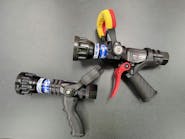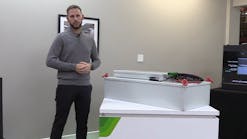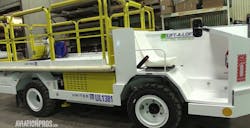London Heathrow's new £4.2 billion ($8 billion U.S.) Terminal 5 (T5) is scheduled to open in March 2008. The 60-gate, 30-million capacity building will be dedicated exclusively to British Airways and provide much needed terminal and airside space at the world's busiest international airport.
The move to T5 will enable the UK carrier to vacate T1 and T4. The size of British Airways in 2008 will mean that the airline's full operation will not immediately fit into Terminal 5 so a small number of services (less than 10 percent) will be located nearby in Terminal 3, alongside BA's oneworld partners, Qantas and Iberia.
T5 is a huge site, comprising 260 hectares-just less than one quarter of the entire Heathrow complex. Approximately 18km of conveyor belt will move bags around while 13.5km of bored tunnels - about one third of the channel tunnel distance - will include connections to the Heathrow Express and Piccadilly Line train services
. The project also involves a new air traffic control tower, a 4,000 space parking lot, a new connection to the M25 motorway, a 600-bed hotel and the diversion of two rivers.
The sheer size of the facility, which will take the airport's capacity to around 90 million passengers per annum, entails significant changes for ground support services.
"T5 brings with it the opportunity for us to change the way we work," says Colin McWilliam, British Airways General Manager Ramp Services. "Not only will there will be less movement for both passengers and staff from terminal to terminal, but by positioning equipment at each individual aircraft stand there will be less movement around the terminal.
"The stands will have their own designated elevators to load cargo and baggage and passenger steps and baggage tugs to help increase effi ciency and improve safety," he adds.
AVAILABLE AND CAPABLE
One of the companies working for BA on the ground is VT Airside Solutions (VTAS), a wholly owned subsidiary of VT plc and previously known as Lex Transfleet Airside Solutions. In 2003 it won a 10-year contract with British Airways to manage and maintain ground support equipment across four UK facilities; Heathrow, Gatwick, Manchester and Birmingham.
The services provided include:
- Fleet Management
- Workshop Management
- Inventory Management
- Whole Life Asset Cost Control
- IT Systems and Processes
- Asset Procurement and Disposal
The contract also includes risk transfer and specific service levels in respect of ground support equipment availability and breakdown response guarantees.
"We basically need to make sure vehicles are available and of the requisite quality," says Gordon Reynolds, airside director, VTAS. "We have to be as efficient as possible and deliver savings for BA. This is done through the timely replacement and good utilization of the 6,500 or so assets."
The nascent T5 project allows Reynolds to describe the situation there as "cradle to grave management for the entire ground support fleet," suggesting the £38 million ($72 million) budget for GSE procurement must be used wisely.
"The design and positioning of T5 means there are plenty of ramps and tunnels to negotiate," Reynolds explains. "Some of the ramps have a one in 19 slope, equivalent to a five percent gradient. This is unique to T5, which means new equipment is needed, particularly baggage tractors."
VTAS has scoured the market to determine availability of the appropriate machines and has also been involved in some research and development projects. The company is also keenly aware of the sensitive environmental situation at Heathrow and will need to ensure vehicle emissions go beyond current EU directives.
"There are two options on BA's table right now," the VTAS director informs. "They can go either for high-powered pure electric vehicles, which have 90-percent more power than those they are using today or they can choose a hybrid, which can be switched between diesel and electric motors as required."
BA is evaluating the available choices. Consideration is being given to a compendium of variables including emissions, speed, longevity, capital and whole life equipment costs as well as the logistics of managing the equipment for either fueling or charging.
"BA is close to making decisions about key equipment," confi rms Austin Lewis, VTAS divisional managing director. "Once ordered, we will deal with manufacturers on warranty issues, making sure we have available spare parts and the suchlike. It can be a complicated process but is an important part of the overall strategy."
NEW PROCEDURES
When the new additions to the fleet start arriving in September 2007, updated maintenance procedures and schedules as well as overhauled training requirements will come into force. "Staff will need to know the capabilities of the vehicles and how to maintain them to the highest standard," says Lewis. "But BA will work some equipment at T5 very hard and although they are very efficient machines, they will need regular check-ups. In any case, our scheduled maintenance checks are often more stringent than necessary or called for by manufacturer's guidelines."
VTAS will have three workshops at LHR. One is actually being built into the T5 campus itself at the eastern end of the airfield. VTAS also operates a workshop adjacent to the World Cargo Centre and has a main base workshop, including a full body shop. In addition, there are seven mobile engineers, who basically act as a rapid response team and deal with any ad-hoc requirements.
These mobile engineers face another of the T5 challenges; enhanced security. Although this is already in effect at Heathrow, the size of the T5 site necessitates it being factored in to the response times and availability schedules. Getting into restricted areas will inevitably take some time, meaning some mobiles must remain airside at all times.
The cargo side of operations also faces changes. The main cargo operation at Heathrow is actually several miles away from T5 and vehicle specification and availability will have to take into account a lengthy journey around the airfield.
Complex procurement such as this is part and parcel of the VTAS offering, however. The company runs a comprehensive IT suite to ensure all BA requirements are handled quickly and effectively.
"We work with BA closely but it tends to be long-term planning rather than any last minute changes caused by flight schedule changes," says Reynolds. "BA tells us its equipment requirements twice a year-for example, how many elevators are needed on a Thursday afternoon in a certain part of the airfield.
"This then gets loaded into our system and we arrange an availability program accordingly. There is complete transparency and BA can see what is available at any time."
This integrated approach with BA will serve the company well as the T5 opening draws near. VTAS will be an integral part of the equipment testing and development before the facility opens, working alongside BA to avoid any potential pitfalls.
"And there will also be a specific plan dealing with the relocation-the physical move from T1 and T4 to T5," notes Lewis. "This is a huge undertaking in itself."
Once completed, BA's McWilliam is in no doubt the terminal will be a great success. "Terminal 5 will transform the flying experience for the millions of British Airways' customers who pass through Heathrow each year," he says. "For the vast majority, the new experience will be faster, smoother and simpler. Ground support services will play a crucial role in ensuring we take full advantage of our new surroundings and ensure the smooth running of the operation."
Willie Walsh, BA Chief Executive, agrees: "T5 offers a once-in-a-lifetime opportunity for our business, our customer and our staff. The move presents us with opportunities and challenges in equal measure. The clock is ticking. Our focus must remain on delivering the changes, and we need to make sure the move in less than 500 days time is a smooth and successful one."





